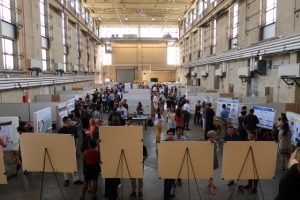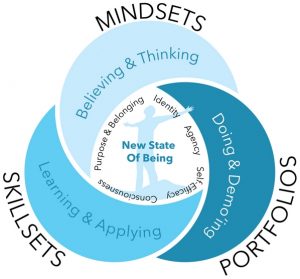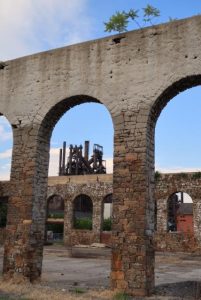Mid July I received a personal invitation to join an “Impact-Focused Education Unconference” at Lehigh University in Pennsylvania. I was skeptic about the unconference with its wordings of “unplanning” and “unorganisation”, but decided to discover new pathways toward innovative best practices in impact-focused higher education, in a group of about 40 educational thought leaders from the US, Canada, Ireland, Philippines and the Netherlands. “Come and join an illustrious cohort of creative, passionate and engaged educators, thought leaders, academic entrepreneurs, and social change makers from around the world as they engage in a series of conversations and pop-up workshops during the Impact-Focused Education Unconference”, the invitation read.
The unconference changed my mind, was very engaging, effective and unexpectedly successful. I acquired more new insights and more new connections than in many conventional conferences.
What is an unconference, and what did I take home?
Unconferencing
Conventional conferences are usually filled with a tyranny of PowerPoint presentations. Most of its content has already evaporated when you are heading home. Whereas an Unconference is supposed to be an intimate and active gathering where creative, passionate and active thought leaders and, in this case, educational transformers share, reflect, learn and create with the aim of accelerate change in higher education. The format allows for spontaneous networking and unstructured learning opportunities.
The Unconference provides an unusual environment. Rather than providing participants with a schedule of speakers to sit through, the sessions work organically. Lecture-style presentations are replaced with small group conversations, emergent conversations and partner work. The participants select their topic of interest and exchange ideas, share proven practices, and build new relationships to upgrade their own programmes and organisations.
The discussions in small groups are about themes that are described in vague and empty wordings (e.g. ‘Scaling Faculty Impact” or “Worldly Creativity”) that provoke different perspectives and spark deep personal connections. For each discussion group the organisation appoints one or two conversation leaders out of the participants who do not necessarily have a strong association with the topic. They structure the discussion and record the headlines on whiteboards or flip charts. Plenary debriefings after lunch and at the end of the day give overviews to everybody.
Venue: the Mountaintop Campus
The event took place inside the former Bethlehem Steel research facilities atop South Mountain, Lehigh University in Bethlehem, PA. In the past, these buildings housed a 500-ton hydraulic press, electron microscopes and thousands of square metres of lab space. Now they are home to an eclectic assortment of equipment. Tables littered with papers, a couple of plants scattered across the ground, a pile of cinder blocks in one corner, sectioned off by cubicles built out of a number of whiteboards. They create a vibrant and unique learning environment for students who have the freedom to pursue answers to open-ended questions in projects while working in, and across all disciplines, and are challenged to acquire information and advance knowledge and understanding, take intellectual risks and learn from failures. This was the venue for the Impact-Focused Education Unconference.

One of the Mountaintop Campus halls that has been transformed from a research lab of Bethlehem Steel into a creative learning space for Inquiry-To-Impact projects and Mountaintop Summer Experience projects that are open for all students. It was also the venue for the Impact-Focused Education Unconference (private photo)
Impact-Focused Education as a leading theme
What skillsets, mindsets, and portfolios prepare students and faculty for impact-focused careers in a rapidly-changing world? What kinds of learning environments do we need to build to prepare the next cadre of scientists, artists, engineers, educators, who are ready to pursue new intellectual pathways and collaboratively address the challenges of our times, and to understand and solve problems that we don’t even know exist? How do we prepare our academic staff to formulate research questions that have a high potential for impact?
Programme
The opening took place in the Tower Room of the Iacocca Hall, atop the mountain that was supposed to give a splendid view on the Bethlehem Steel plant in the valley. But thunderstorms, heavy rainfall and fog put us literally in the Cloud right from the beginning. It was a good metaphor for the setting of an Unconference.
We started with three rounds of duo conversations to introduce each other. Discussing reflective questions like “What is a discovery you’ve made about unleashing yourself?”; “What is energizing for you in your role in educational transformation”, “What fears or anxieties do you face in transformation work?”; “What role can your emotions and body feelings play at this unconference?”
In the session that followed we prepared for the mindset “Impact in education”, where I introduced the impact of the VUCA world on education. We learnt
“Impact = Significance * Scale”
and that society demands higher education to prepare graduates, not for excellence in research, but for Impact and Innovation. People made references to “42 Silicon Valley” – Disrupting Engineering Education, and the book A New Culture of Learning by Douglas Thomas and John Seely Brown. Doubts raised about the impact Generation-Z may have in future because of their shallow depth of knowledge. For impactful innovation deep knowledge is needed, but the classrooms are filled with the Google generation.
Impact-impact-impact
We discussed the impact on education by the new breed of students who become more demanding consumers of educational services. We also discussed the impact by the trend that on-demand learning is going to outperform traditional linear curricula in keeping skillsets up to date, and that abstract courses are more and more replaced by “learning experiences” that yield the same, or better, outcomes for the learners. In these learning experiences students not only learn to analyse and solve problems, but learn to solve only those problems that matter for impact and innovation.
With the mindsets of all participants aligned with the theme, the group split. Everybody picked one out of three parallel conversations of between 75 and 90 minutes. The topics of the conversation sessions were about “Scaling Faculty Impact”, “Interdisciplinary Projects”, “Civic Engagement and Inclusive Excellence”, “Faculty Development”, “Making Change Happen” from respectively student, faculty and administrator’s perspective in three parallel sessions, and “Skillsets, Mindsets and Portfolios for Impact”.
Portfolios of accomplishments
Conversations at the Unconference about portfolios gave me a different perspective. Staff in engineering and sciences at my university are reluctant, even allergic to portfolios. Only our Faculty of Industrial Design Engineering and Faculty of Architecture and the Built Environment use portfolios as a showcase of projects, products or performances. Their use focuses on the admission process.
Establishing a portfolio during a study in Delft is neither the norm nor stimulated. It is supposed to demand a lot of argumentation and persistence for students to compose and write, and for staff to review, give feedback and not to forget, to grade and allocate credits. But that’s all faculty-centred thinking. That is the way we have been administrating since decades. When we are serious to adopt a student-centred approach in our education, we have to understand that we should neither grade nor allocate credits to portfolios.
The portfolios we discussed are Portfolios of Impact, a (digital) platform of expression of somebody’s identity. These are key in student-centred education. They are not just a log of problems solved or a showcase of products etc over time, but a synthesis of what somebody has learnt, what he or she has done, and who he or she is. They include personal growth in and outside the university. In Georgia Tech all students build such portfolio over their four years undergraduate study. They write and rewrite multiple times their individual story of development: “How did I create value during my study?” Alumni highlight the added value of a good portfolio for a future job. The students are coached in portfolio writing, by providing good examples and checklists, and in giving feedback to each other. Peer reviewing these portfolios by students is powerful. Students sometimes choose to split a portfolio in a personal and public part.
The participants of the Unconference expected that portfolios of accomplishments, containing a synthesis of skillsets and mindsets, will soon be equally important as university diplomas as a prerequisite for a job. The job market in the US and large multinationals like Ernst & Young and Google have already started assessing the competency levels of their future employees on the basis of portfolios.
Establishing a Portfolio for Impact during the study is an excellent way for students to learn “job crafting” to market themselves. Not only for their first job, but for their career.






To all attendees of the Unconference,
There is an excellent book by Tina Seelig from Stanford called “InGenius.” In her book she presents a Mobius strip framework of education, part of which I suggest be adopted to give context to Khanjan’s Mindset-Skill Set-Portfolio model.
With my 40 plus years of engineering entrepreneurship education, it is my opinion that a missing part of Khanjan’s framework is the creation and support of an Innovation and Entrepreneurship (I&E) Ecosystem that includes the need to focus on what Seelig describes as Culture, Habitat and Resources. In my opinion without these three key components we are all just continuously spinning our wheels with few impactful sustainable and scalable results; always working on the margins of our time and efforts. Also by including ecosystem or infrastructure issues, we challenge the faculty and administration as a community to acknowledge their collective responsibility to create and support new learning-focused environments and curricula.
My complete model would include a surrounding circle of an I&E Ecosystem with Mindset-Skill Set-Portfolio embedded in the center. My educational framework would have the goal of supporting “continuously innovating curricula” and my implementation would start with developing key components of each school’s I&E ecosystem, followed by a mindset-first first-year experience, then skill set development with the continuous creation of student personal portfolios as the documentation of their accomplishments as well as their character development throughout the remaining semesters of their education.
My gray hairs tell me that without a culture change that focuses on student learning rather than faculty teaching and research, without the resources to support experiential learning rather than chalk and talk lectures, and without the appropriate learning spaces and make-and-measure labs as opposed to 600 fixed-seat lecture halls, education will remain right where it is now and where it was 25, 50 or 100 years ago.
Thanks for considering my 2-cents worth of feedback.
John B Ochs
Soon to be Professor Emeritus
Mechanical Engineering and Mechanics Department
Technical Entrepreneurship Programs
Lehigh University
Excellent!!!
Thank you